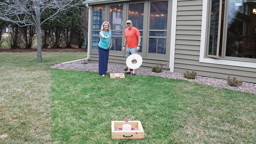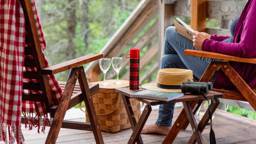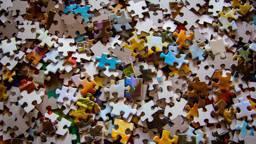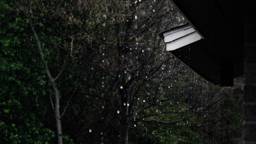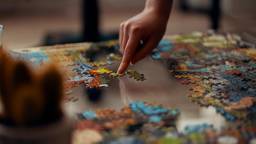Scrapbooking serves as a creative outlet, a heritage to pass on to your children and a way to communicate the stories behind your photographs. But, above all, scrapbooking is about preserving memories, allowing you to artfully display photos and memorabilia in a way that captures the spirit and history of your place.
Getting Started
Scrapbooking does not need to be expensive, elaborate or time-consuming. All you need are a few basic supplies (see Supplies List), which are easily found at a scrapbook or crafts store. If you don’t have a crafts store where you live, you can find a multitude of online scrapbooking sites that have all these items — plus much, much more.
To begin documenting your cabin memories, select several photos with a common theme and choose cardstock in a color that complements your photographs. In “Cabin Memories,” I chose four photos that represent my favorite memories and added cabin-themed paper to reinforce my story.
Next, crop your photos with scissors or a paper cutter to highlight the photo’s focal point. Arrange the photos on the page in an aesthetically pleasing manner and secure them with an acid-free adhesive. Add a title and you have the foundation for a stunning page.
Complete your layout with embellishments — decorative elements that add interest and dimension to your page. Embellishments include traditional items like stickers, ribbon and buttons, or even objects from nature like pressed flowers or dried leaves — virtually any object that you can adhere to a page. Embellishments help add the “wow” factor and reinforce your story. In “Cabin Memories,” I added wooden letters and rustic elements to reinforce my cabin theme.
Capturing Your Stories
Journaling — telling the stories behind your photos — is an important part of the scrapbooking process. Journaling helps convey the details of your life not revealed through photographs and that may be forgottenten over time. Journaling also helps splash a little of your own personality onto the pages of your scrapbook.
Journaling has no hard and fast rules. It can convey the “who, what, where, when and why” of the event or incorporate snippets of conversation, colorful poetry or poignant narratives. You can journal on paper, on an embellishment or a page element, or directly onto your scrapbook page. You can also type your journaling in a word processing program using a variety of fonts and colors, then print, crop and adhere it to the page. In “Sunset,” I typed a poem directly on the photograph, while in “Cabin Memories” I wrote my favorite memories on a piece of digital notebook paper.
Surviving the Generations
To make your scrapbook last for generations, use products that are acid-free, lignin-free and fade-resistant. Acid will accelerate the deterioration of photographs while lignin — a natural, acidic bonding substance found in many papers — will cause papers to yellow or become brittle over time. When choosing scrapbook supplies, look for “photo safe” or “archival quality” labels.
If you want to incorporate memorabilia or other products onto your page, a pH tester pen can help you determine if it’s acid-free (a pH of 7+). If the product is not acid-free, you can neutralize it with a de- acidification spray, found in craft and scrapbook stores or online.
Display your layouts in acid-free albums that open flat. Avoid magnetic albums which contain acidic adhesive or vinyl sleeves which affect the emulsion of the photographs as the vinyl deteriorates.
Digi-scrapping
Digital scrapbooking — or “digi-scrapping” — is a digital alternative to traditional paper scrapbooking that allows you to create stunning pages on your computer. All you need is a computer, a printer and image-editing software — Adobe Photoshop and Corel PaintShop Pro are two popular options. Papers and embellishments can be downloaded to your desktop from the hundreds of scrapbook sites on the Internet (type “digital scrap- booking” into any Internet search engine to open the digital floodgates).
To get started, download a few free sample digi-scrapping kits from sites like twopeasinabucket.com, designerdigitals.com and shabbyprincess.com (look for “freebies” or “digital downloads”). Open a new document in your image-editing software, choose your background paper and drop in your digital photos. Finish by typing in your journaling and adding embellishments, much like a traditional page. You can also use your scanner to add objects and images to your layouts for a truly custom look. Finally, print the completed page and drop it in your album, post it to an online site or e-mail it to friends.
Digital scrapbooking is a tremendous time-saver because you don’t need to crop or adhere items to your page. You can also take advantage of “Quick Pages” which allows you to drop your photos into pre-designed templates to complete a layout in minutes (see “Lovin’ the Lake” for an example of this). Digi-scrapping is great for creating gift albums because you can print and distribute multiple copies.
Digi-scrapping also eliminates the cutting and gluing of traditional scrapbooking because the products reside in digital form on your computer, making it a great option for scrapping at the cabin. Simply load your digital photos onto your computer’s hard drive and instead of toting a trunk load of scrapbook supplies to your cabin, all you need is your laptop.
Scrapbooking is a fun and easy way to capture your memories. The growing array of supplies and digital tools give you more creative choices than ever. The next time you want to preserve your cabin memories, consider documenting them in a scrapbook.
Supplies List
- Cardstock: This thick, durable paper is avail-able in many textures.
- Patterned paper: This is a thinner paper that comes in many different sizes, can be purchased in multi-packs and is either single or double-sided.
- Acid-free adhesive: Use glue, tape runners or double-stick adhesive to ensure everything sticks and your photographs won’t fade or deteriorate too fast.
- Scissors or a paper trimmer
- Journaling pens
- Memory album
- TIP: Look for products that have passed the Photographic Activity Test (PAT), an international standard that indicates that a product is safe to use with photographs.




